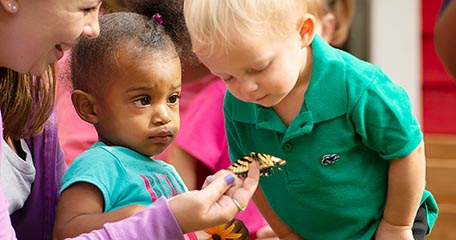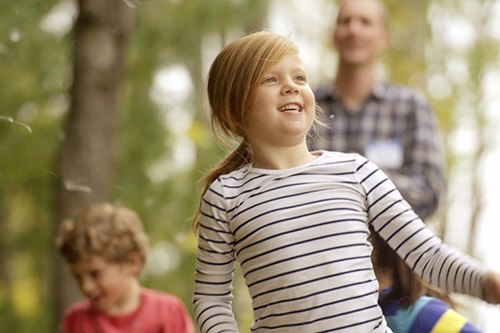Open-ended play at home!
| May 2020How can young children’s waking hours be both happy and purposeful, despite the stress of our times? Dozens of arts and crafts activities can be found on the internet (including on this website!). While these ideas can be helpful and educational in proportion, children may become over-stimulated or frustrated if these are the primary occupation. You can exhaust yourself trying to provide supplies, giving constant instructions, and cleaning up the mess before moving on to the next project. Try open-ended play.
So what is open-ended play?
Open-ended play is play with no pre-determined limitations or “right” or “wrong” set outcomes. It allows children the time and space to develop their own ideas, follow the pull of their own creativity and process experiences. All areas of learning are supported in open-ended play by using simple materials, most of which are probably in your home already. Once established, this type of play can be repeated day after day. Watch as your kids work on their early science, maths, literacy, communication, fine motor and construction skills.
Initially you may need to play too, as a child may not immediately know what to do with the materials offered. Once children understand the possibilities of using play items, you can retreat and let them get on with it. They’ll begin to explore ideas, discover new possibilities and use their extremely amazing imaginations.
Open-ended play can take place anywhere: indoors or outdoors. Most of us are currently caring for our kids in living/sitting rooms, and if we are lucky enough to have gardens, outdoors too.
Even for babies and toddlers, open-ended play provides stimulation and an exploratory experience. Offer empty plastic containers, shoe-boxes, jar lids and kitchen pots or pans, and they’ll want to collect, dump and post. Children will discover new sounds and textures as they tap, roll and drop play items. Add a few bits of cloth, and they’ll soon begin covering and uncovering and even playing peek-a-boo.
Open-ended play with blocks
Block play is an educational and exciting form of open-ended play. An individual block may become an animal or storybook character. In the early stages of block play, a child may start by simply lugging blocks around, making piles, or lining them up. Eventually they begin stacking blocks into simple towers or houses. Then construction expands to castles, bridges, farms or ships. Adding the final block to a build is not necessarily the end of a construction session. Seashells, pine-cones, scraps of cloth and buttons (with supervision!), and toy animals or cars work great for decorating the structure, or can be moved around it in imaginative play. This type of small world play engages the imagination and will encourage children to retell stories or re-enact an event they have participated in (check out the importance of oral language).
Role-play
“Imagination is more important than knowledge.” – Albert Einstein
Role-play is another form of open-ended play that can happen right at home. No elaborate costumes are needed. Supplied with a few old shirts, scarves and perhaps a hat or two, children quickly transform themselves into princesses, firemen, Spidermen and (believe it or not) mums or dads that bear a striking resemblance to their own. Gloves, cooking aprons, fabric shopping bags, doll dishes, yogurt cups, and best of all: bowls and spoons from your very own kitchen enable kids to serve picnics to their stuffed toys right in your living room. A few old boxes make great tractors and trains too. Sorting and tidying away should also be part of the play session, of course!
Den building
Den building is an all-time favourite of young children. Allow children to move chairs, a low table or other safe lightweight furniture to form an enclosure. Add a large cloth or duvet to create the cosiest den of your dreams. Your child is now a bear in a cave or simply has his own home. He or she might enjoy just sitting in the den taking time to daydream and soliloquise, or may wish to have a toy, teddy or book for company.
“These small, secret worlds are calm, ordered and reassuringly secure. They allow for privacy, imagination and temporary ownership, and are important ways that children can feel a sense of agency in shaping and creating their own special place, making their mark on the world.” – Helen Tovey, Playing Outdoors: Spaces and Places, Risk and Challenge (2007)
Open-ended play outdoors
The outdoors offers natural sensory stimulation of sunlight and shadow, damp and dry, mud, plants and fresh air, and is ultimately the best environment for open-ended play. Availability of outdoor spaces at home of course varies greatly, but even the smallest garden or patio can become a creative play area for children. With twigs, dirt and pebbles, a child becomes engrossed in creating and building. If you have a garden, leaves and sticks become a fairy house with leaves arranged as little plates for small world or role play. A child's imagination is limitless: pine cones are served as potatoes and shredded dandelion leaves, decorated with dandelion flowers, as a gourmet salad. Seashells, conkers or painted stones may all be added to enhance the fun.
Mud kitchen
A mud kitchen provides endless possibilities for creative and open-ended role play. Even if you don’t have a proper mud kitchen yet, you can start out with a working surface at a comfortable working height: perhaps an old bench, low table or simply a plank raised across two stumps or breeze-blocks. Dirt, soil, sand or other natural materials should be freely accessible in either an open or a contained area. For example, an old car tire could be filled with dirt or wood chips. A few old kitchen dishes, including pots and pans, ladles, spoons and pitchers equip children to mix, cook, bake and serve. Your kids will want to return to this play area the next day and continue their work.
Water play
In warmer weather, children delight in playing with water, allowing it to trickle through their fingers and plunging their hands in and out. Yes: wet, messy, educational, and most importantly fun. Containers of water can also be added to the mud kitchen or washing-up basins filled and placed on the grass or in a sandpit if you have one. Children pour, fill and tip using funnels, scoops, pitchers and buckets. Observe how their vocabulary and understanding of the world expands as they experiment and talk about empty and full, light and heavy, floating and sinking. As with all water play with young children, these activities will need close supervision; any container filled with water is a drowning hazard.
Conclusion
Open-ended play is an essential component of a happy childhood. During the current challenging circumstances brought on by the COVID-19 pandemic, it is vital that kids are allowed daily opportunities for free play, offering them security and a chance to relax. Given the freedom to explore and imagine, children will discover the world around them, develop physically and intellectually, and gain confidence. Wishing you the best of luck as you journey on through these tough times!














